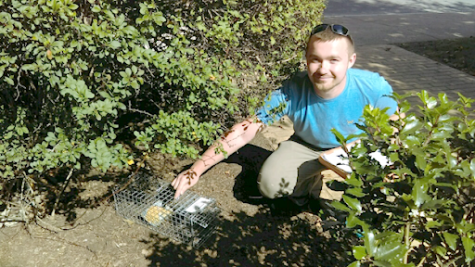Understanding ecosystems through squirrel personality
A research team at Wilkes University is hoping to learn how bravery and boldness on the part of grey squirrels impacts a vital ecological process.
The team, led by Dr. Micheal Steele, professor of biology, is studying how different personality types among individual squirrels affect seed dispersal in local woodland areas.
Seed dispersal is necessary for tree reproduction and the future replenishing of forests.
Some tree species are simply able to have their seeds dispersed by the wind. But others, like oak trees, produce heavier acorns, meaning they have to rely on animals to disperse their seeds for them.
That is where the grey squirrels come in, at least with many species of oak trees. These squirrels engage in a behavior called scatter hoarding. Scatter hoarding is when acorns are buried at multiple cache sites. The squirrels will often return to retrieve their acorns for a meal. However, when squirrels fail to retrieve one of these caches, the seeds are free to sprout and grow.
But what determines whether these caches are retrieved or not? What determines where these caches are buried?
One of the biggest factors is the risk of predation, which is when a squirrel is hunted or killed by a predator. A second factor is the ‘preferability’ of the seeds. This refers to how easily the acorns can be stored and how much energy the squirrel will gain from eating the seeds. Preferability is based on economic models, meaning the energy cost of the squirrel moving to the cache site, burying the cache and later retrieving the cached food must be accounted for as well.
“We’ve shown that, in this oak dispersal system, more preferred seeds are carried further away from the source tree,” Steele said. “We’ve also shown that, when the squirrels carry the seeds out into the open, despite the presence of other animals, they are not retrieved.”
To understand why some individual squirrels choose safer cache sites than others, it is becoming increasingly necessary to look at the ‘boldness,’ as scientific literature refers to it, of the squirrel’s personality. This is a fairly recent development in behavioral ecology.
Ecologists have traditionally treated all members of a given species as being identical or near-identical when it comes to behavior. In more recent years, the focus has been shifting to differences among individuals and how this can influence a given ecosystem.
“For decades we have studied animal ecology from the perspective that this species does this and this [other] species does that, when in fact some individuals within a species may vary as much as different species with regards to what they do,” added Steele.
When applying these new ideas to oak seed dispersal, Steele and his team have hypothesized that the ‘bold’ grey squirrels aid in the reproduction of oaks by carrying the seeds to riskier, more open cache sites where they are harder to retrieve.
To effectively test this, the team has been working on campus through the summer to develop effective research methods and protocols.
One of the team members is Tyler Brzozowski, senior biology major. He commented on his work with Steele’s research.
“The most challenging part is structuring our research experiments and getting them to ‘work.’ Referencing the Personality Study, we had to create our protocol from scratch by referencing similar studies done by other scientists,” said Brzozowski.
Some traveling around campus may have noticed traps in the bushes or squirrels with curious dye spots on their fur. This is all part of the team’s work.

Brzozowski sets up a squirrel trap on campus for the research they did over the summer.
The procedure starts with catching squirrels in the traps, processing them by identifying gender, age, weight and marking their fur with dye.
Vikki Hoffman, a team member and junior biology major, describes what it’s like to handle the squirrels.
“I’d say it’s stressful at first trying to transfer them from the trap when they could be very excited or even seem aggressive,” she said. “Once they move into the cloth restraining cone, they get snug and barely move, some fall asleep. Squirrels feel slightly squishy and warm to hold. We are constantly feeling their breathing and heartbeat when we restrain to make sure they’re alright. Their safety comes before the study and we never want to overstress them.”
That’s not to say nothing ever goes wrong when dealing with these bushy-tailed research subjects.
“I may have been the first to accidentally release a squirrel into the lab,” Hoffman admits. “But at least we know what to do now [in that situation]. And we don’t keep glass items on high shelves anymore. You live and you learn.”
Once processing is complete, the squirrel is placed in a multi-chambered apparatus to determine its personality type. A bold squirrel will climb over walls and move from chamber to chamber exploring its new surroundings. A shy or timid squirrel will tend to remain in the original chamber.
Once the squirrels are classified and identifiable, they are released. In the coming months, the ‘real’ study will begin as this procedure will be applied to the squirrels living at Kirby Park in Wilkes-Barre: the study site.
This three-year study is being made possible by a $300,000 grant from The National Science Foundation of Poland, the largest grant that the organization awarded in 2019. It will be a collaborative investigation between Wilkes, UC Davis, the University of Maine and a group of researchers in Poland. However, not all teams will be looking at specifically grey squirrels.